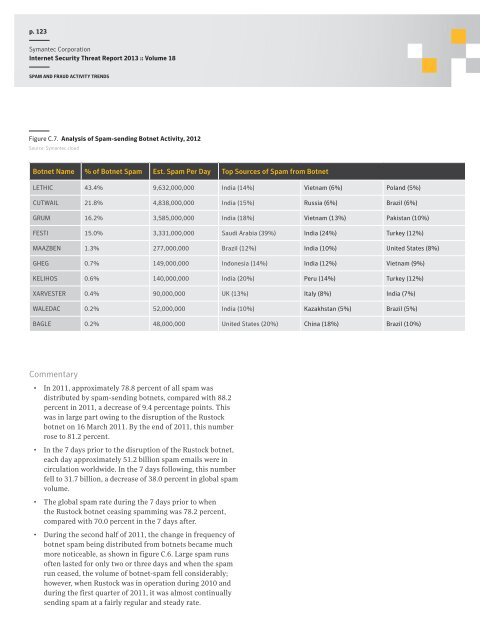internet security tHreAt rePOrt GOVernMent 2013
internet security tHreAt rePOrt GOVernMent 2013
internet security tHreAt rePOrt GOVernMent 2013
You also want an ePaper? Increase the reach of your titles
YUMPU automatically turns print PDFs into web optimized ePapers that Google loves.
p. 123<br />
Symantec Corporation<br />
Internet Security Threat Report <strong>2013</strong> :: Volume 18<br />
SPAM AND FRAUD ACTIVITy TRENDS<br />
Figure c.7. Analysis of Spam-sending Botnet Activity, 2012<br />
Source: Symantec.cloud<br />
Botnet Name % of Botnet Spam Est. Spam Per Day Top Sources of Spam from Botnet<br />
LetHic 43.4% 9,632,000,000 india (14%) Vietnam (6%) Poland (5%)<br />
cutWAiL 21.8% 4,838,000,000 india (15%) russia (6%) Brazil (6%)<br />
GruM 16.2% 3,585,000,000 india (18%) Vietnam (13%) Pakistan (10%)<br />
Festi 15.0% 3,331,000,000 saudi Arabia (39%) india (24%) turkey (12%)<br />
MAAZBen 1.3% 277,000,000 Brazil (12%) india (10%) united states (8%)<br />
GHeG 0.7% 149,000,000 indonesia (14%) india (12%) Vietnam (9%)<br />
KeLiHOs 0.6% 140,000,000 india (20%) Peru (14%) turkey (12%)<br />
XArVester 0.4% 90,000,000 uK (13%) italy (8%) india (7%)<br />
WALeDAc 0.2% 52,000,000 india (10%) Kazakhstan (5%) Brazil (5%)<br />
BAGLe 0.2% 48,000,000 united states (20%) china (18%) Brazil (10%)<br />
Commentary<br />
• In 2011, approximately 78.8 percent of all spam was<br />
distributed by spam-sending botnets, compared with 88.2<br />
percent in 2011, a decrease of 9.4 percentage points. This<br />
was in large part owing to the disruption of the Rustock<br />
botnet on 16 March 2011. By the end of 2011, this number<br />
rose to 81.2 percent.<br />
• In the 7 days prior to the disruption of the Rustock botnet,<br />
each day approximately 51.2 billion spam emails were in<br />
circulation worldwide. In the 7 days following, this number<br />
fell to 31.7 billion, a decrease of 38.0 percent in global spam<br />
volume.<br />
• The global spam rate during the 7 days prior to when<br />
the Rustock botnet ceasing spamming was 78.2 percent,<br />
compared with 70.0 percent in the 7 days after.<br />
• During the second half of 2011, the change in frequency of<br />
botnet spam being distributed from botnets became much<br />
more noticeable, as shown in figure C.6. Large spam runs<br />
often lasted for only two or three days and when the spam<br />
run ceased, the volume of botnet-spam fell considerably;<br />
however, when Rustock was in operation during 2010 and<br />
during the first quarter of 2011, it was almost continually<br />
sending spam at a fairly regular and steady rate.


